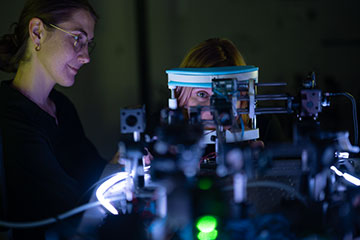
Researchers in Poland have determined the luminance of two-photon vision stimuli. [Image: ICTER/Karol Karnowski]
Under the right circumstances, the human eye can see an ultrashort pulse of infrared laser light. This relatively new phenomenon, dubbed “two-photon vision,” could lead to better detection and understanding of sight-robbing retinal diseases.
To harness two-photon vision, though, scientists need to measure it properly. Now, researchers in Poland have developed a new method for determining the brightness of two-photon visual stimuli (Biomed. Opt. Express, doi: 10.1364/BOE.525180). They hope this technique will enable applications in both medical diagnostics and augmented/virtual reality.
Not one, but two photons
In normal vision, the process of phototransduction occurs after the retina absorbs one photon of energy sufficient to excite the relevant visual pigment to a higher energy level, says Katarzyna Komar, a physicist at the International Center for Translational Eye Research. For example, humans perceive photons of 500-nm light as green because the pigments present in the retina’s M-cones mostly absorb the photons.
However, in two-photon vision, the retina absorbs two photons from a pulsed near-infrared laser and isomerizes the visual pigments that sense light at about half the wavelength of the incoming infrared light. The human brain “sees” green in the 500-nm range because pulsed 1000-nm light stimulates the pigments in the M-cones due to two-photon absorption.
Scientists have long applied two-photon absorption to microscopy and photopolymerization, but it was only about a decade ago that researchers discovered that the process could trigger the brain to perceive visible light.
Measuring the sensation
“The concept of two-photon retinal illuminance was created precisely as an attempt to measure what a person actually sees,” says Komar, who is also affiliated with the Polish Academy of Sciences and Nicolaus Copernicus University. Photometric measures, such as candelas, lumens and lux, measure the brightness of sources of one-photon vision, but there have been no such measures for two-photon vision. Komar and her colleagues thus sought to compare two stimuli to measure the perceived brightness of the two-photon stimulus.
In their experiments, the team shone pulsed laser beams, one at 520 nm and the other at 1040 nm, at eye-safe power levels into the retinas of six healthy participants. According to Komar, the team scanned the subjects’ retinas in a special optical configuration, called a Maxwellian view, that is also used in scanning laser ophthalmoscopes.
“We presented to our subjects two stimuli [at] the same time. The first was perceived by one-photon vision and the second by two-photon vision, and [we] asked them to match the brightness,” Komar says. Each participant adjusted the brightness of the visible stimulus (as they perceived it) to match the brightness of the infrared stimulus.
The team demonstrated that the brightness of two-photon stimuli is proportional to the square of the laser power per area on the illuminated retina (W2/m2).
This setup was so different from a normal view (such as looking at a computer screen) that a conventional luminometer could not handle it, Komar says. Instead, the researchers learned how to express their results in terms of the troland, a unit that describes the illuminance level on the retina.
The team demonstrated that the brightness of two-photon stimuli is proportional to the square of the laser power per area on the illuminated retina (W2/m2). For one-photon vision, the brightness depends on power per unit area (W/m2), while two-photon depends quadratically, not linearly, on power, Komar says.
Looking to the future
According to Komar, the results could be used in two-photon microperimetry, a type of visual test that measures the sensitivity of the retina to light in cases of glaucoma, diabetic retinopathy or age-related macular degeneration. Current tests use one-photon microperimetry, but Komar says that infrared light would better penetrate cataracts without the need for removal surgery.
Komar is continuing to study the characterization of two-photon vision and standards for measuring two-photon brightness and colors. Her team is also working on two-photon displays for augmented-reality technology. The researchers also seek further development of two-photon microperimetry; prototype systems are already being tested clinically in Heidelberg, Germany, and at the University of California, Irvine, USA.
“For efficient data collection from real patients we have to improve these systems because we definitely need more data collected on patients with particular retinal diseases to push this technology to the upper level,” Komar says.
